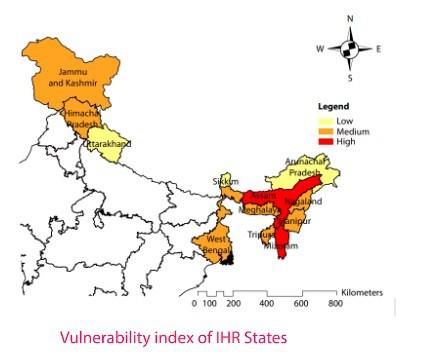Mains Daily Question
Dec. 4, 2023
Q3. Indian Himalayan region (IHR) has its vulnerabilities. In this context, explain the challenges of unregulated tourism in the IHR. (10M, 150W)
|
Approach: Introduction: You can mention current affairs related to disasters in IHR or mention the states included in this region. Body: Heading 1: Explain the vulnerabilities associated with IHR in terms of different dimensions. Conclusion: Give a way forward tone showing a futuristic approach for achieving sustainable tourism. |
Answer: The recent landslides in Himachal Pradesh and the breach of the Teesta dam in Sikkim are reminders of the ecological impacts resulting from our development approach in the mountainous Indian Himalayan Region.
Indian Himalayan region (IHR) covers 11 states (Himachal Pradesh, Uttarakhand, Sikkim, all northeast states, and West Bengal) and 2 UTs (Jammu & Kashmir and Ladakh).
Specific vulnerabilities of the IHR
- Geo-physical Challenges: The Himalayas are tectonically active and consist mainly of unconsolidated and semi-consolidated deposits.
- Undercutting by river currents in valleys like Alaknanda, Bhagirathi, and Mandakini, along with hill washing and water percolation, contribute to land subsidence, as witnessed in Joshimath, Uttarakhand.
- Socio-economic Impact: Deforestation on hill slopes for agriculture, grazing and construction leads to avalanches and landslides.
- For instance, the construction of mega hydel Power Projects like Tehri Dam Reservoir obstructs natural water flow, also causing the relocation of communities
- Tourism Pressure: With around 100 million annual tourists, the IHR is projected to face an increase to 240 million by 2025, intensifying resource strain.
- As per Niti Aayog, tourism contributes over 10% to the Gross State Domestic Product in states like Uttarakhand, West Bengal, Tripura, Assam, etc.
- Climate Change: Rising extreme warm events with increased variability in western disturbances and a higher probability of snowfall in specific Himalayan regions acts as a force multiplier making landslides, flash floods and cloudbursts more disastrous.
- For instance, Glacial burst flooding the Rishiganga river and Uttarakhand forest fires are few examples of the same.
Challenges of unregulated tourism in the IHR
- Waste Generation: As per a Niti Aayog report, tourism in IHR States generates over 8 million tonnes of solid waste annually.
- The lack of organized waste management contributes to the degradation of watersheds and water sources.
- Forests and Biodiversity Impact: The construction of tourism infrastructure like accommodation and transport, results in the loss of natural forest covers.
- Landscape Alteration: The replacement of eco-friendly infrastructure with unsafe constructions alters the landscape puts enormous stress on local land use, and can lead to soil erosion, increased pollution, natural habitat loss etc.
- Water deficiency: Ladakh is a water-deficient region, which is mostly dependent on snow / glacial melt and the flow of the River Indus.
- Here, individual water consumption by a resident is 75 litres per day on average, whereas a tourist consumes about 100 l / day.
- Socio-cultural Erosion: Mass tourism contributes to the erosion of the cultural fabric and social values of collectivism, impacting the socio-cultural identity of the region.
Unregulated tourism that exceeds the region’s carrying capacity can have disastrous impacts. Developing a comprehensive sustainable tourism strategy, Monitoring the carrying capacity, and implementing regulations like Solid Waste Management Rules, 2016 in the Indian Himalayan region can ensure proper tourist capacity, minimizing pollution and biodiversity degradation.


